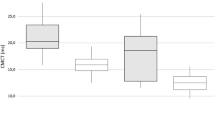Abstract
Background
Hereditary spastic paraplegia (HSP) include various sporadic and hereditary neurodegenerative disorders, characterized by progressive spasticity and weakness of lower limbs, possibly associated to additional features.
Case presentation
We report a male HPS patient in his 40 s, showing mental retardation associated with language impairment, dysarthria, and increased urinary frequency. Three months after treatment with electric chronic high-frequency cervical spinal cord stimulation (HF-SCS), he showed an amelioration of motor symptoms (lower limbs spasticity and gait), dysarthria, cognitive functioning (language and constructive praxic abilities), and urinary symptoms (decreased urinary frequency). Single-photon emission computed tomography (SPECT) showed a postoperative increase of cerebral perfusion in right frontal cortex and temporal cortex bilaterally.
Conclusion
In our patient, HF-SCS might have induced an activation of ascending neural pathways, resulting in changes in activity in various cortical areas (including sensory-motor cortical areas), which may give rise to a modulation of activity in spared descending motor pathways and in neural networks involved in cognitive functions, including language. Although further studies in patients with HPS are needed to clarify whether HF-SCS can be a suitable treatment option in HSP, our observation suggests that HF-SCS, a minimally invasive neurosurgical procedure, might induce beneficial effects of on various symptoms of such orphan disease.

Similar content being viewed by others
References
Schule R, Wiethoff S, Martus P et al (2016) Hereditary spastic paraplegia: clinicogenetic lessons from 608 patients. Ann Neurol 79:646–658
Shribman S, Reid E, Crosby AH, Houlden H, Warner TT (2019) Hereditary spastic paraplegia: from diagnosis to emerging therapeutic approaches. Lancet Neurol 18:1136–1146
Faber I, Branco LM, FrançaJúnior MC (2016) Cognitive dysfunction in hereditary spastic paraplegias and other motor neuron disorders. Dement Neuropsychol 10:276–279
Tallaksen CM, Guichart-Gomez E, Verpillat P, Barma VH, Ruberg M, Fontaine B, Brice A, Dubois B, Durr A (2003) Subtle cognitive impairment but no dementia in patients with spastin mutations. Arch Neurol 60:1113–1118
McMonagle P, Byrne P, Hutchinson M (2004) Further evidence of dementia in SPG4-linked autosomal dominant hereditary spastic paraplegia. Neurology 62:407–410
Cioni B, Meglio M, Prezioso A, Talamonti G, Tirendi M (1989) Spinal cord stimulation (SCS) in spastic hemiparesis. Pacing Clin Electrophysiol 12:739–742
Broseta J, Garcia-March G, Sánchez-Ledesma MJ, Barberá J, González-Darder J (1987) High-frequency cervical spinal cord stimulation in spasticity and motor disorders. Acta Neurochir Suppl 39:106–111
Mayr W, Krenn M, Dimitrijevic MR (2016) Epidural and transcutaneous spinal electrical stimulation for restoration of movement after incomplete and complete spinal cord injury. Curr Opin Neurol 29:721–726
Hofstoetter US, McKay WB, Tansey KE, Mayr W, Kern H, Minassian K (2014) Modification of spasticity by transcutaneous spinal cord stimulation in individuals with incomplete spinal cord injury. J Spinal Cord Med 37:202
Craven BC, Morris AR (2010) Modified Ashworth scale reliability for measurement of lower extremity spasticity among patients with SCI Spinal Cord. 48:207–13. https://doi.org/10.1038/sc.2009.107
Apolone G, Mosconi P (1998) The Italian SF-36 health survey: translation, validation and norming. J Clin Epidemiol 51:1025–1036
Davis RB, Ounpuu S, Tyburski D, Gage JR (1991) A gait analysis data collection and reduction technique. Hum Mov Sci 10:575–587
Piano C, Ciavarro M, Bove F, Di Giuda D, Cocciolillo F, Bentivoglio AR, Cioni B (2020) Tufo t, Calabresi P, Daniele A (2020) Extradural motor cortex stimulation might improve episodic and working memory in patients with Parkinson’s disease. NPJ Parkinsons Dis 6:26
Serrao M, Rinaldi M, Ranavolo A, Laquaniti F, Martino G, Leonardi L, Conte C, Carrecchia R, Craicchio F, Coppola G, Casali C (2016) Pierelli F (2016) Gait patterns in patients with hereditary spastic paraparesis. PLoSOne 11:e0164623
Vallejo R (2012) High-frequency spinal cord stimulation: an emerging treatment option for patients with chronic pain. Tech Reg Anesth Pain Manag 16:106–112
Ardolino G, Bocci T, Nigro M (2018) Spinal direct current stimulation (tsDCS) in hereditary spastic paraplegias (HSP): a shamcontrolled crossover study. J Spinal Cord Med. 44:46–53. https://doi.org/10.1080/10790268.2018.1543926
de Souza CP, Coelho DB, Campos DFS et al (2021) Spinal cord stimulation improves motor function and gait in spastic paraplegia type 4 (SPG4): clinical and neurophysiological evaluation. Parkinsonism Relat Disord 83:1–5
Lee YC, Lee SC, Chiu EC (2022) Practice effect and test-retest reliability of the mini-mental state examination-2 in people with dementia. BMC Geriatr 22(1):67
Visocchi M, Giordano A, Calcagni M et al (2001) Spinal cord stimulation and cerebral blood flow in stroke: personal experience. Neurosurg 76:262–268
Mazzone P, Viselli F, Ferraina S et al (2019) high cervical spinal cord stimulation: a one year follow-up study on motor and non-motor functions in Parkinson’s disease. Brain Sci 3(9):78
Marangolo P, Fiori V, Shofany J et al (2017) Moving beyond the brain: transcutaneous spinal direct current stimulation in post-stroke aphasia. Front Neurol 8:400. https://doi.org/10.3389/fneur.2017.00400
Ciavarro M, Grande E, Bevacqua G et al (2022) Structural brain network reorganization following anterior callosotomy for colloid cysts: connectometry and graph analysis results. Front Neurol 13:894157. https://doi.org/10.3389/fneur.2022.894157.eCollection
Author information
Authors and Affiliations
Corresponding author
Ethics declarations
Ethical approval
None.
Conflict of interest
The authors declare no competing interests.
Additional information
Publisher's note
Springer Nature remains neutral with regard to jurisdictional claims in published maps and institutional affiliations.
Rights and permissions
Springer Nature or its licensor (e.g. a society or other partner) holds exclusive rights to this article under a publishing agreement with the author(s) or other rightsholder(s); author self-archiving of the accepted manuscript version of this article is solely governed by the terms of such publishing agreement and applicable law.
About this article
Cite this article
Tufo, T., Ciavarro, M., Di Giuda, D. et al. Spinal cord stimulation may improve gait and cognition in hereditary spastic paraplegia with mental retardation: a case report. Neurol Sci 44, 961–966 (2023). https://doi.org/10.1007/s10072-022-06487-w
Received:
Accepted:
Published:
Issue Date:
DOI: https://doi.org/10.1007/s10072-022-06487-w




